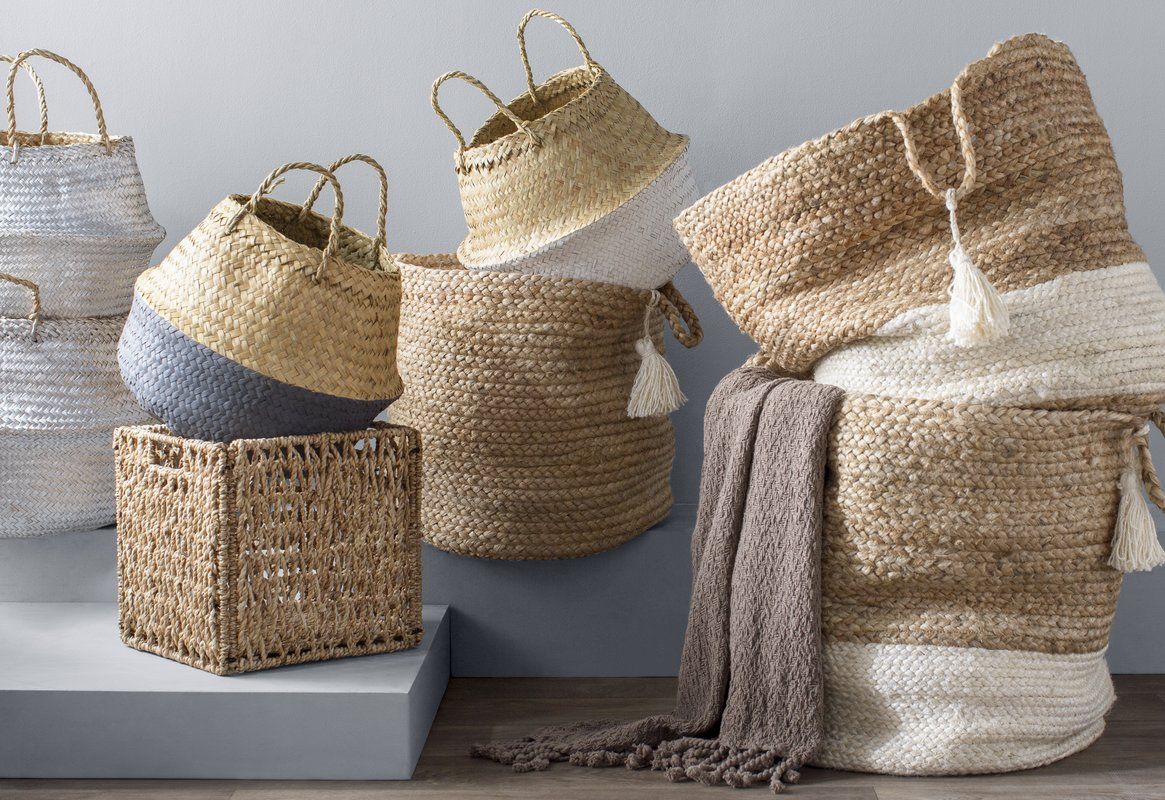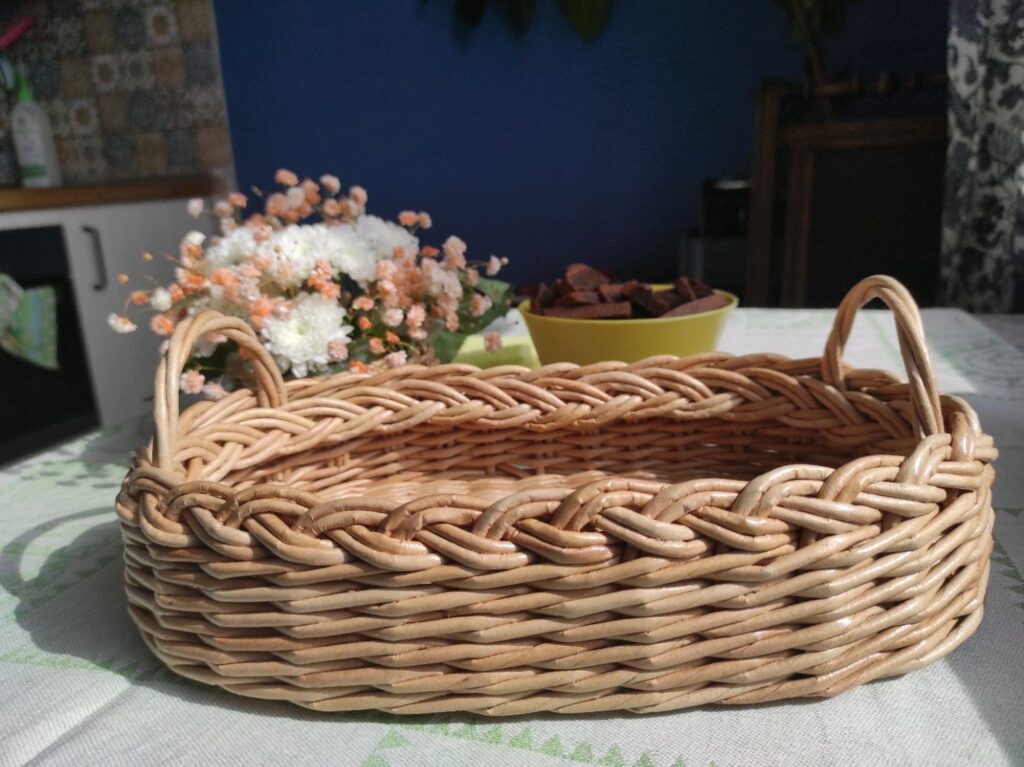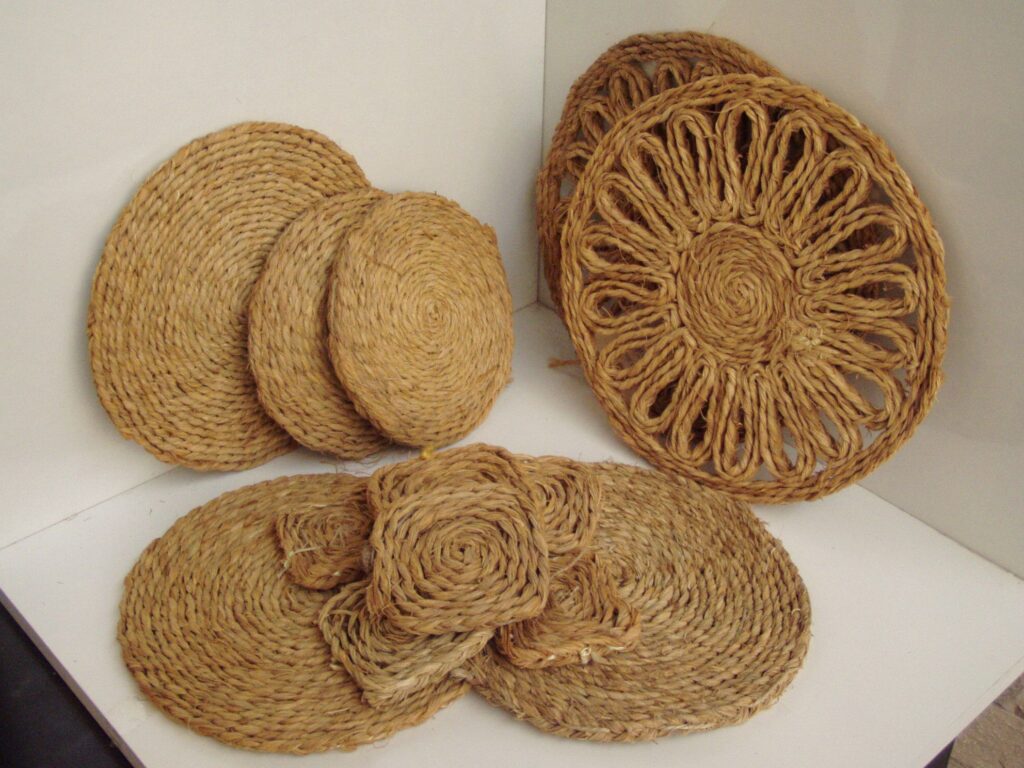Jute Handicrafts in Bangladesh: A Cultural Heritage of Beauty

Jute Handicrafts in Bangladesh hold a special place in the heart. It symbolizes both tradition and innovation.
These handicrafts intertwine artistic expression with functional utility. It helps to produce items that range from apparel to home decor.
They encapsulate the essence of Bangladeshi identity, echoing the country’s rural heritage and urban dynamism alike.
To truly appreciate the present, one must understand the past.
From ancient weaving techniques to the colonial era’s global Jute trade, the evolution of these crafts is closely tied to the nation’s economic and social shifts.
By tracing the journey of Jute from its early uses to its contemporary artistic applications, we gain insights into the enduring legacy that has shaped Bangladesh’s cultural heritage.
The Rich History of Jute in Bangladesh
Jute is often referred to as the “Golden Fiber.” It has played a pivotal role in shaping Bangladesh’s history, economy, and culture. We now delve into the multifaceted history of Jute. Starting from its ancient origins to its modern significance as a cultural and economic cornerstone.
Early Origins:
The history of Jute cultivation can be traced back to ancient times in the Indian subcontinent. Jute was primarily grown for its long, strong fibers. They were used for making ropes, twines, and textiles. The warm and humid climate of the region provided ideal conditions for Jute cultivation.
Rise of the Jute Industry:
During the British colonial period, the Jute industry experienced significant growth. The demand for Jute products increased. As the fiber gained popularity for its durability and affordability.
Jute mills began to emerge in the late 19th century, particularly in Bengal, India, and later in other countries like Bangladesh.
Technological Advancements:
The late 19th and early 20th centuries saw significant advancements in Jute processing technology.
Manual methods were gradually replaced by mechanical processes. Such as the development of Jute-spinning machines and power looms. These innovations increased production efficiency and output.
Economic Impact:
Jute cultivation and processing became major contributors to the economies of countries like India and Bangladesh.
These nations emerged as the world’s leading producers of Jute fiber and products. They account for a substantial portion of global Jute trade.
Challenges and Sustainability:
While the Jute industry prospered, challenges such as competition from synthetic fibers and fluctuating market demand emerged.
Efforts were made to modernize processing techniques and diversify Jute products to maintain the industry’s viability.
Environmental Awareness:
As concerns about environmental sustainability grew, Jute’s natural properties became more appreciated.
Jute is biodegradable, renewable, and has a lower environmental impact compared to synthetic fibers. This led to renewed interest in Jute as an eco-friendly alternative in various industries.
Contemporary Scenario:
In recent decades, Jute cultivation and processing have undergone transformations to meet modern demands.
Research has focused on developing finer and softer Jute fibers. They are used for applications in textiles, home furnishings, and even fashion.
Popular Jute Handicraft Products in Bangladesh

Source: https://www.emaze.com/
Jute handicrafts encompass a diverse range of products. It showcases the natural beauty of Jute fiber while reflecting the artistic ingenuity of Bangladeshi artisans.
These sought-after Jute handicraft products have gained acclaim both domestically and internationally.
Jute Baskets: Versatile Creations for Every Need
Jute baskets, woven with care and ingenuity, transcend mere utility. They bridge the gap between necessity and aesthetics. They seamlessly integrate into diverse settings while offering practical solutions for everyday needs.
From cradling newborns in gentle comfort to neatly organizing laundry and belongings, Jute baskets emerge as versatile creations that harmoniously blend form and function.
Baby Holder Basket
Jute baby holder baskets combine functionality and aesthetics. They provide a charming and eco-friendly way to cradle infants.
These baskets are handwoven with care, offering a safe and comfortable space for newborns.
Jute Laundry Basket
Jute laundry baskets offer a stylish solution for organizing laundry while adding a touch of rustic elegance to any space. Their durability and natural appeal make them a popular choice for modern homes.
Jute Storage Basket
Jute storage baskets are a practical addition to homes. They serve as effective organizers for various items. Their intricate designs and sturdy construction make them an ideal blend of form and function.
Jute Placemats & Coasters: Nature-Inspired Table Decor
Jute placemats and coasters infuse dining spaces with a touch of nature-inspired beauty. These intricately woven pieces not only protect surfaces but also add an earthy charm to meals and gatherings.
Jute Bags: Exquisite Ladies Bags
Jute bags for women are a true testament to the fusion of tradition and contemporary fashion. Handcrafted by skilled artisans, these bags boast intricate designs that cater to a modern lifestyle.
Cultural Significance of Jute Handicrafts in Bangladesh
Jute handicrafts in Bangladesh are more than just artistic creations. They are powerful representations of tradition, culture, and identity.
From adorning festivals to representing sustainability, these handicrafts showcase the rich heritage and values of the Bengali people.
These traditions continue to be celebrated and passed down through generations. Jute remains an enduring symbol of Bangladesh’s deep-rooted connection with its history and culture.
Jute Handicrafts in Bengali Festivals and Celebrations: Source: livemaster.ru
Source: livemaster.ru
Bengali festivals and celebrations are marked by vibrant colors, rhythmic music, and a strong sense of cultural identity. Jute handicrafts play an integral role in these festivities. They add a distinct touch of authenticity and traditional charm to the celebrations.
Various Jute products are used for decoration and gifting. They create an ambiance that resonates with the essence of the occasion.
Pohela Boishakh (Bengali New Year):
Pohela Boishakh is celebrated with great enthusiasm in Bangladesh. And Jute handicrafts find their way into the heart of the celebrations.
Intricately designed Jute banners, wall hangings, and decorative items featuring traditional motifs and messages of well-wishes adorn homes, streets, and marketplaces.
These Jute decorations not only create a festive atmosphere but also reflect the cultural pride of the Bengali people.
Durga Puja:
Durga Puja is one of the most significant religious and cultural events in Bengal. It showcases the convergence of art, devotion, and heritage.
Jute is often used to create life-sized idols of goddess Durga and her entourage.
These Jute-made idols are skillfully crafted by artisans. They celebrate the connection between nature and divinity.
Additionally, Jute craft stalls are set up during the puja. They display an array of products like bags, accessories, and home decor items that carry a blend of modernity and tradition.
Jute Handicrafts as a Symbol of Tradition and Identity:
Jute handicrafts serve as potent symbols of tradition and identity for the people of Bangladesh. It reflects their heritage, values, and aspirations.
Rooted in Tradition:
Jute has been intertwined with the history of Bengal for centuries. Handicrafts made from Jute fibers evoke a sense of nostalgia and continuity with the past.
Through the skillful hands of artisans, traditional Jute products like rugs, baskets, and wall hangings preserve age-old weaving techniques.
Cultural Identity:
The use of Jute in various forms of art and craft reinforces the cultural identity of Bangladesh. These creations serve as visual representations of the nation’s distinctive cultural heritage. Making them valuable ambassadors of Bangladeshi culture on the global stage.
Sustainability and Environment:
Jute’s eco-friendly nature aligns with the values of sustainability and environmental consciousness.
As the world shifts toward more sustainable practices, Jute handicrafts gain prominence not only for their aesthetic appeal but also for their contribution to a greener planet.
This aligns with the values of many Bangladeshis who are proud of their nation’s role in producing a renewable and biodegradable resource.
Challenges and Revival Efforts in the Jute Handicraft Industry of Bangladesh
The challenges faced by the Jute handicraft industry in Bangladesh are real and multifaceted. But the determination to preserve this rich heritage is equally strong.
Through a combination of government initiatives and the dedication of NGOs, the Jute handicraft industry is undergoing a revival.
By addressing modern challenges, fostering skill development, and promoting market access, these efforts are not only safeguarding a craft but also empowering artisans and upholding the cultural legacy of Bangladesh.
Modern Challenges Faced by the Jute Handicraft Industry:
The Jute handicraft industry confronts a host of contemporary challenges that jeopardize its viability and growth.
Competition from Modern Alternatives:
The rise of modern materials and production methods poses a significant challenge to Jute handicrafts.
Synthetic materials and mass-produced items often offer cost-effectiveness and uniformity. It can overshadow the uniqueness and authenticity of Jute crafts.
Changing Consumer Preferences:
As consumer preferences shift towards sleek and contemporary designs, traditional Jute handicrafts can sometimes be perceived as outdated.
This change in taste can impact the demand for these crafts. Making it difficult for artisans to sustain their livelihoods.
Lack of Skill Transfer:
The intricate techniques involved in Jute handicrafts are often passed down through generations. However, younger generations may be more inclined towards modern professions. This leads to a potential loss of these invaluable skills and techniques.
Limited Market Access:
Many skilled artisans lack proper market access and exposure to a broader consumer base. This limits their ability to sell their products and earn a decent income. This pushes them to seek alternative livelihoods.
Government and NGO Initiatives to Preserve and Promote Jute Crafts
Both government agencies and NGOs are taking active steps to address the challenges faced by the Jute handicraft industry and ensure its survival.
Skill Development and Training:
NGOs are collaborating with artisans to provide skill development and training programs. These initiatives aim to enhance artisans’ skills. This introduces innovative designs and ensures a continuous influx of new talent into the craft.
Market Access and Promotion:
Efforts are being made to connect artisans with local and international markets. Trade fairs, exhibitions, and online platforms are being utilized. This showcases Jute handicrafts to a wider audience, thereby increasing their marketability.
Financial Support and Incentives:
The government has introduced financial schemes and incentives for artisans to encourage their participation in the craft industry.
These include low-interest loans, grants, and subsidies. It alleviates the financial burden on artisans and encourages them to continue their craft.
Reviving Traditional Designs:
NGOs are working closely with artisans to revive traditional designs and techniques while infusing contemporary elements.
This helps maintain the authenticity of the crafts. While making them relevant to modern consumer preferences.
Awareness and Advocacy:
NGOs are engaged in raising awareness about the cultural significance and environmental benefits of Jute handicrafts.
This not only instills a sense of pride in artisans but also educates consumers about the value of supporting traditional crafts.
Jute Handicrafts in the Global Market: Expanding Trends and Opportunities

Source: murciaturistica.es
Jute handicrafts are deeply rooted in the cultural heritage of Bangladesh. They have transcended national borders to establish their presence in the global market.
With a unique blend of tradition, sustainability, and craftsmanship, Jute handicrafts are gaining recognition and appreciation from international audiences.
As demand grows, the global market for Jute handicrafts holds immense potential for economic growth, cultural preservation, and the promotion of sustainable practices.
Ethical Consumerism:
Many consumers prioritize ethical sourcing and fair labor practices. Jute handicrafts often involve traditional artisanal practices that support local communities. Making them appealing to socially conscious buyers.
Unique Aesthetic Appeal:
Jute’s natural texture and earthy tones offer a distinct aesthetic that resonates with contemporary design trends.
Jute products add an element of authenticity and warmth to interior spaces. Attracting many interior designers and decorators.
Customization and Innovation:
Collaborations between artisans and designers have led to innovative applications of Jute in various products. From fashion accessories to home decor items, the versatility of Jute is being explored through creative designs and techniques.
Craftsmanship and Authenticity:
Handcrafted Jute products carry a sense of authenticity and human touch that mass-produced items lack. This authenticity appeals to consumers looking for unique and meaningful items.
Design Innovation:
International designers bring fresh perspectives and design sensibilities to traditional Jute crafts. The design collaborations often result in products that bridge the gap between traditional and modern aesthetics. Making Jute products more appealing to a wider audience.
Global Exposure:
Partnering with renowned international brands and designers gives Jute Handicrafts access to global distribution networks and marketing platforms. This exposure helps showcase the craftsmanship and cultural heritage of Bangladesh to the world.
Cross-Cultural Fusion:
Collaborations provide an avenue for cross-cultural exchange. Designers from different parts of the world infuse their design philosophies with traditional Jute techniques. This results in products that celebrate diversity and artistic fusion.
Conclusion
As we draw the threads of this exploration together, it becomes evident that Jute handicrafts are more than just items of beauty. They are vessels of culture, history, and human ingenuity.
These crafts are not just static artifacts; they are living testaments to the hands that shape them and the stories they carry.
The legacy of the Jute Handicrafts in Bangladesh goes beyond its economic contributions. It intertwines with the essence of Bangladeshi culture.
From festivals to daily life, Jute handicrafts remain steadfast as symbols of tradition, identity, and resilience.
They remind us that culture is a living, breathing entity that evolves with time while holding onto its roots.
In the intricate weavings of Jute baskets, the vibrant hues of Jute textiles, and the creative collaborations between artisans and designers.
We find a journey that encapsulates the soul of a nation. The path forward involves honoring tradition while embracing innovation. It ensures that the threads of Jute continue to be woven into the vibrant tapestry of Bangladesh’s cultural heritage.
